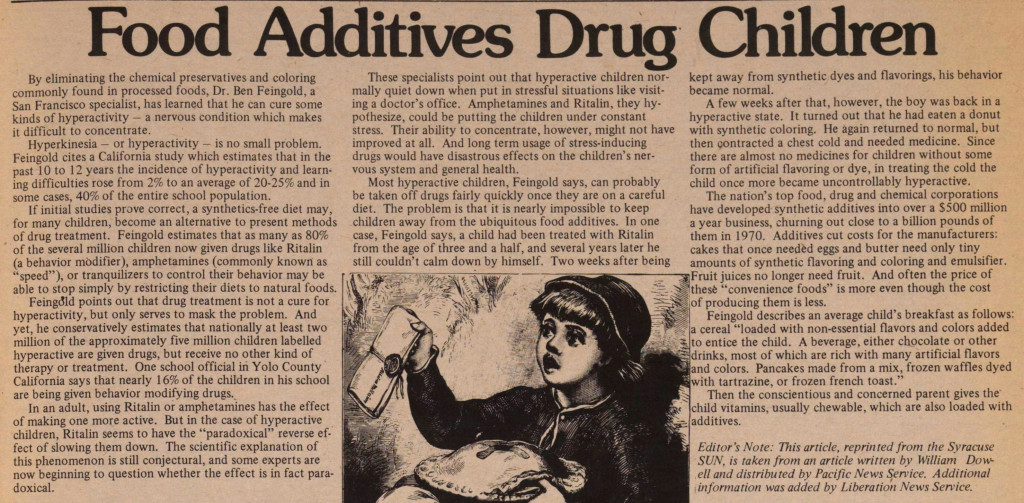 During the 1970s the headlines read: food additives drug children—and result in drugging children, researchers say. But this wasn’t enough to convince health policy or medical professionals, creating a confusion for parents.
During the 1970s the headlines read: food additives drug children—and result in drugging children, researchers say. But this wasn’t enough to convince health policy or medical professionals, creating a confusion for parents.
During the 1980s headlines read: New research shows possible link between food additives and hyperactivity.
During the 1990s we put a name on it: Possible ADHD link with food dyes and additives according to new research. And so it goes…
Except none of it is “headline” news given Theron Randolf published her observations “Allergy as a causative factor of fatigue, irritability, and behavior problems in children” in the Journal of Pediatrics in 1947. Yes, we’re ignoring the hundreds of well done studies making a connection between ingredients added to our food and the behaviors we see in ourselves and our children.
The Center for Science in the Public Interest has a nice summary here that all adds up to this:
Additives used in hundreds of children’s foods and drinks can cause temper tantrums and disruptive behavior.
Creating a monster: Your child wants to behave; so why don’t they?
A UK Government-funded study confirms what many parents have long suspected about the effect of chemicals put into sweets, biscuits and foods. Colorings in common food products spark behavior changes in toddlers.
Once again reveals young children are more likely to lack concentration, lose their temper, interrupt others and, in this study, struggle to take naps when they drink fruit juice dosed with sugar, colorings and preservatives.
But unlike earlier studies, this study grabbed the attention of food watchdog The Food Commission has now found that at least 200 children’s foods and drinks contain one or more of the additives called into question by the research.
Because of this, the Commission is calling for the additives to be removed from the everyday foods and drinks which appeal to children. “Even youngsters with no history of hyperactivity can be affected,” said the scientists. They conclude that “all children could benefit from the removal of specified artificial food colourings from their diet.”
Think big: If it has a label, it isn’t food.
Here’s the short list: five food additives you should avoid:
1. Artificial Colors – anything that begins with FD&C (e.g. FD&C Blue #1)
2. Chemical Preservatives – Butylated Hydroxyanisole (BHA), Sodium Nitrate, Sodium Benzoate
3. Artificial Sweeteners – Aspartame, Acesulfame-K, Saccharin
4. Added Sugar – High Fructose Corn Syrup (HFCS), Corn Syrup, Cane Sugar, Dextrose, Maltodextrose etc.
5. Added Salt – Look at the sodium content and choose foods with the lowest amounts.
Of course after evaluating six decades of studies implicating artificial dyes in behavioral disorders, in 2011 the FDA concluded that: “Exposure to food and food components, including artificial food colors and preservatives, may be associated with adverse behaviors, not necessarily related to hyperactivity, in certain susceptible children with ADHD and other problem behaviors, and possibly in susceptible children from the general population.”
The food additive study.
To test change in mood and behavior, a group of 227 three-year olds drank a daily fruit juice dosed with artificial colorings and preservatives at levels at or below those permitted. For two weeks the children were given a single drink with these additives.
For the other two weeks the children drank a fruit juice that was identical in appearance but without the additives. Parents filled in reports assessing their child’s behavior on criteria such as interrupting, fiddling with objects, disturbing others, difficulty settling down to sleep, concentration and temper tantrums.
The scientific conclusion about food additives and behavior?
Artificial food colorings and sodium benzoate preservative have “substantial effects” on behavior.
The food industry response?
“The research was not conclusive.” states a spokesman for the Government’s Food Standards Agency.
“The food additives it uses are permitted by European and UK laws and any additives or colours have been tested to the highest standards.” says Nestlé.
“We certainly wouldn’t use any additives unless they were approved as safe.” says GlaxoSmithKline
“Our biscuits contain only half the amount of Carmoisine stated in legal guidelines.” said Burton’s Foods.
Eating habits are learned behaviors; they’re not intuitive. What your children learn to eat at home early in life sticks with them well into adulthood.
Most of us know that our children are under continuous assault by corporate food advertising and insane social habits. We are frustrated by it, and sometimes it feels we are powerless against it. It’s difficult when children visit friends—there is a desire to conform. Parties and school events are especially difficult. So many other parents feel they have to bring cakes and icings, artificial drinks… cheap bulk foods.
We remain disconnected from our food sources and pay little attention to what is going on. Fewer and fewer Americans cook meals from scratch. Even I catch myself being in a hurry and grabbing something fast on the way home from work. And the guerilla marketing foisted upon us by fast-food and processed-food companies, even “natural” or “healthy,” isn’t helping.
Ensure the long-term nutritional health of your child.
1. Create social, whole-family meals. Make mealtime special
So many parents complain that their children refuse to eat healthfully. They want alternate foods that “look” like the ones everyone else is eating, some magic recipe to put an end to the madness. We cave in at the first sound of “mommy I don’t like that.” Believe me, a hungry enough child will like “that” and especially when they all sit down and mommy and daddy are excited about the food. But I’ve seen parents do a whole dance preparing the child for this new and different and healthy and “you’ll like it” and “I know it’s different” and… it hasn’t even finished cooking!
What about simply creating enjoyment around family meals? Make mealtime fun and all about family. First and foremost, sit down and enjoy your food. Take time to savor flavors.
Children should never eat while walking around but younger ones do have difficulty sitting still for long meals; especially if the conversation becomes more adult (some of it can and should, just maybe not for too long). Work out how your family wants to address this. Younger children can have breaks or leave after a certain time or… All ages can be told that it is important to the family that everyone sit down to eat and talk together. Agree to pleasant, not stressful and definitely not argumentative time to talk about everyone’s day and upcoming plans.
And read the other ideas that follow to greatly decrease the amount of time it takes for children (and some adults) to try new things.
2. Let everyone contribute; “family meal jobs”
Most of us are so accustomed to eating out and buying prepared foods that we short-change ourselves. Heck, we don’t even know what to do with all but a few vegetables. We line our pantry with deserts and sodas, expect our children to fend for themselves and then become disappointed when dinner is a PB&J or can of sodium benzoate soup or, in a hunger state, they demolish that container of ice-cream.
Give everyone a special task and allow them to create their own ideas on it—reward creativity with praise. Depending on age, each child can have a night a week to plan a side dish, how the table is set, or even the entire dinner. Create a safe environment to learn and one that fosters contribution to the agreed family structure and pattern.
3. Let kids help in the kitchen.
Children love to help; we usually don’t let them because we’re in too big a hurry. Even a two-year old can help peel potatoes or carrots—it is our job to create an encouraging environment. And they may need a few gadgets: smaller children might need “my cooking stool” to safely reach the kitchen counter. If you have room, set up a workstation at your child’s height. Create a drawer with “my cooking tools” for your child.
Know your child’s limits and help him achieve success by providing support and encouragement in a safe setting.
Children love eating food they create and they also love the role of caregiver. Do you have some nutritional needs? Ask them to help you take care of your body by making the sautéed chard, or selecting smoothie greens. Remember, contribution is ownership, they might even try the new ingredient if they’ve made it for you with love. Every thank-you helps people feel valued.
Involve your child in cooking or snack preparation and they will be more likely to eat new foods, including fruits and vegetables.
3. Get your child up for a good breakfast
Breakfast is the most important meal of the day, and should also be the largest meal of the day. Jumpstart everyone’s metabolism in the morning so our bodies don’t enter starvation mode, which might later cause them to experience difficulty maintaining a healthy body weight.
Starting anyone off with sugar first thing in morning is a big error, but especially children. This gives a quick burst of energy and then leaves you drained. Adults can sometimes push through this, but growing bodies cannot. Their focus, schoolwork, behavior and athletics all suffer; 25 percent of children with disciplinary problems are reacting to those first-thing-in-the-morning food additives. Others simply ran out of fuel.
Breakfast should always include a source of protein and some healthy fats for a long energy burn. If you’re having trouble getting your child to eat breakfast you may need to have them start small. For most children, breakfast should be around 500 calories and should be nutritionally balanced but higher on the protein side.
4. Bring your children shopping
 No, I am not nuts. Yes, initially this requires time and patience—but it gets easier. Create an experience when you’re not in a hurry by mentally assigning this to “youth development.” It’s important for children to see food options, especially raw, produce, meat counters. Let them explore and ask questions. Occasionally, go out to a farm stand or farmers’ market to help develop a connection with good, whole (unprocessed) foods.
No, I am not nuts. Yes, initially this requires time and patience—but it gets easier. Create an experience when you’re not in a hurry by mentally assigning this to “youth development.” It’s important for children to see food options, especially raw, produce, meat counters. Let them explore and ask questions. Occasionally, go out to a farm stand or farmers’ market to help develop a connection with good, whole (unprocessed) foods.
Plan your shopping list to spend more time in the whole foods sections of your grocery store—you can even explain how stores are organized with the “real food” around the edges (the produce, meat, and fish departments) and the processed foods in the many isles. Older children can help find chemicals in the ingredients lists. If your child appears to be interested in a certain type of fruit or vegetable, encourage him or her to explore that item; don’t just assume that your child won’t like it and please never tell them that. Take a small amount home and them try it and make their own decisions.
Exploring food this way gives children a chance to talk about how things are cooked and where food comes from. It empowers children to make choices about what they eat.
5. Be temperate!
Moderation is key. Of course, if you eat doughnuts in moderation, followed by potato chips in moderation and soda in moderation, it is not moderate and not healthy. Develop the “80-20” rule or “90-10” rule depending on your personal beliefs. Go over with your children how all sugar and starches make people fat, cause chronic inflammation, even cancer. Let them know that doesn’t mean they can never have any, ever, but that as a family you want to greatly cut back—keep everyone healthy for longer and stop getting sick all the time.
While every bite really does count, it is not helpful to create emotional stigmas. A special treat once a week or so, preferably adapted to using more healthful ingredient choices, doesn’t really cause that much damage. Help your child build a good relationship with food.
6. Don’t be a short-order cook
Do you make one meal for the adults in the house and another for the children—or even one for each child? If you keep giving children their old standbys they’re not going to branch out and explore new foods. Be patient.
It takes an average of ten to twelve attempts before a child will try a new food unless they are involved in cooking and/or gardening projects. This is why many progressive schools are creating school gardens, youth-lead cafes and other engaging programs that foster interest and culinary adventure.
Definitely make the same dinner for everyone. Do put some foods on the plate that your children like—then also add something new and expect them to at least taste it. But don’t make an argument out of it. Do express your own enjoyment of the newly-tried food. Or, if it truly is unpleasant (as opposed to new), DO offer that it doesn’t taste very good or the texture is off or… laugh a little, talk about how to make it better or never. Create a climate where the cook is neither embarrassed or degraded nor is the food necessarily enforced.
But do get them to at least taste it. If you, yourself enjoyed it, serve it again the next week alongside something they like. Taste buds take a bit to change. When we habitually eat sugary or starchy foods it can take a bit to adjust to more healthful options. But don’t be a slave to this.
7. Don’t buy into marketing for kids
 No one needs frozen chicken nuggets, French fries, macaroni and cheese, pizza, fruit loops, donuts or most advertized goodies to keep them happy. These highly processed foods are loaded with chemicals, synthetic fats, additives, sugar, artificial sweeteners, and food colorings. Unfortunately, television ads and movie product positioning is prevalent and extremely influential.
No one needs frozen chicken nuggets, French fries, macaroni and cheese, pizza, fruit loops, donuts or most advertized goodies to keep them happy. These highly processed foods are loaded with chemicals, synthetic fats, additives, sugar, artificial sweeteners, and food colorings. Unfortunately, television ads and movie product positioning is prevalent and extremely influential.
Even a three-year-old can truly grasp why sodas and super-sweet juices aren’t good for you and why we don’t eat pre-made foods with lots of bad stuff every day at every meal.
But you can’t keep heavily processed foods out of their lives forever. Making food from scratch instills more healthy eating habits. The younger you can start and the more you do this, the more likely your children will make better choices when left to their own devices or offered “treats” at friends.
More than 2.5 million children have been diagnosed with Attention Deficit Hyperactivity Disorder (ADHD) and an additional 15 percent of children have borderline hyperactivity or behavioral issues. Nearly 100 studies validating the hypothesis that food dyes and additives are a factor in attention and behavior disorders and can increase the incidence of ADHD. In one of those studies 73 percent of children placed on a diet free from chemical additives, dyes, and artificial sweeteners showed a reduction in hyperactivity and an increase in attention.
Perhaps just knowing this will strengthen your own resolve when your child thinks he might implode without blue applesauce, or never ever be invited to another party without that double chocolate chip cookie dough ice cream (fat free). Hold your ground. I’ve done “blind Taste tests” between products made with unhealthy ingredients and more wholesome versins.
8. Never use food as rewards, bribes, or punishments!
Don’t give in! Even teachers can be asked to use pencils, stickers other items work just as well and don’t set a precedent or pattern of binge eating.
On the flip side, don’t punish children for not eating certain foods—it will foster a negative relationship between you and your children, not to mention your children and food.
10. Love and accept your child no matter what!
Children can succeed at any size, weight, or shape. Growth can be unpredictable comes in spurts. There’s a lot of pressure in our society to be thin. Yes you do need to help your child eat well, but children shouldn’t get into short-term “dieting” any more than adults. Poorly formed diets, improper nutrition, and emotional stigmas cause emotional and physical damage—this may be harder to break if started as a child.
The best way to help your child is to teach and follow good healthy eating habits and encourage your child to be active. Get involved in activities that keep everyone moving and create healthy outlets for all that kid energy. It might be a challenge at first—anything new can be challenging—but there is always a role for a parent beyond “chauffeur.” Some of my fondest memories are my black-belt son kicking my b*** in Karate in a “winner takes all” only to win it back on the ski slope (for now).
[contact-form-7 id=”1851″ title=”Question form blog page”]
Key References
Rapp DJ and Crook WG The Lancet, Volume 319, Issue 8281, Page 1128, 15 May 1982 doi:10.1016/S0140-6736(82)92314-5
SwansonJM,KinsbourneM. Food dyes impair performance of hyperactive children on a laboratory learning test. Science 1980;207: 1485-1487.PubMed
McCann D, Barrett A, Cooper, A, et al. Food additives and hyperactive behaviour in 3-year-old and 8/9-year-old children in the community: a randomised, double-blinded, placebo-controlled trial. The Lancet, Volume 370, Issue 9598, Pages 1560 – 1567, 3 November 2007
CrookWG. Can what a child eats make him dull, stupid or hyperactive?J Learn Disabil 1980;13(no. 5).
RandolphTG. Allergy as a causative factor of fatigue, irritability, and behavior problems in children.J Pediatr 1947;31:560.PubMed
RappDJ. Does diet affect hyperactivity? J Learn Disabil 1978;11:383. PubMed
Randolph T. Human ecology and susceptibility to the chemical environment. Springfield: Charles C. Thomas, 1962.






